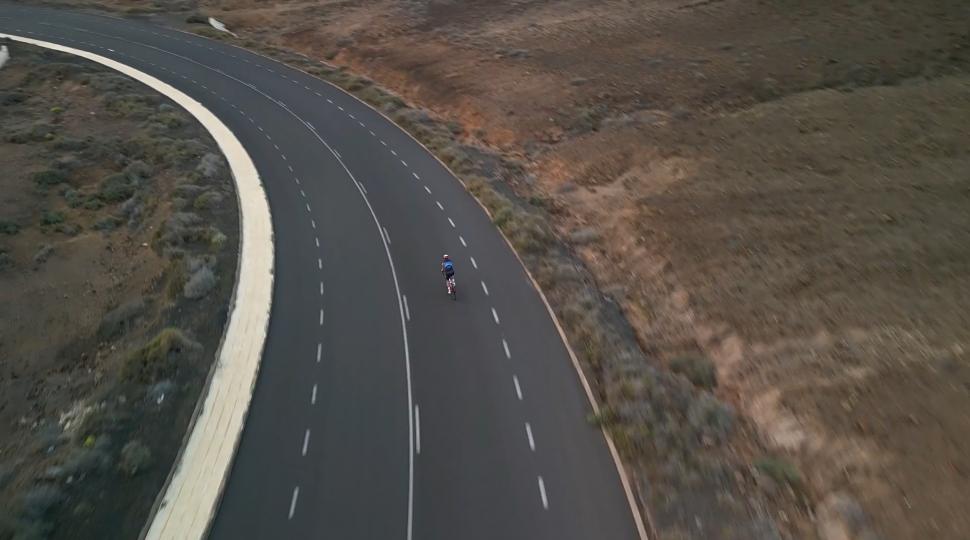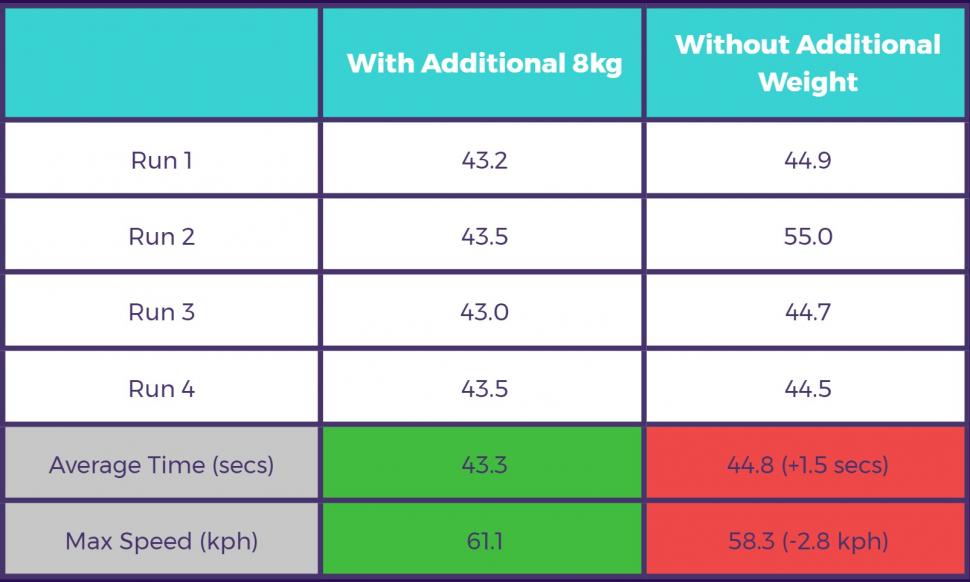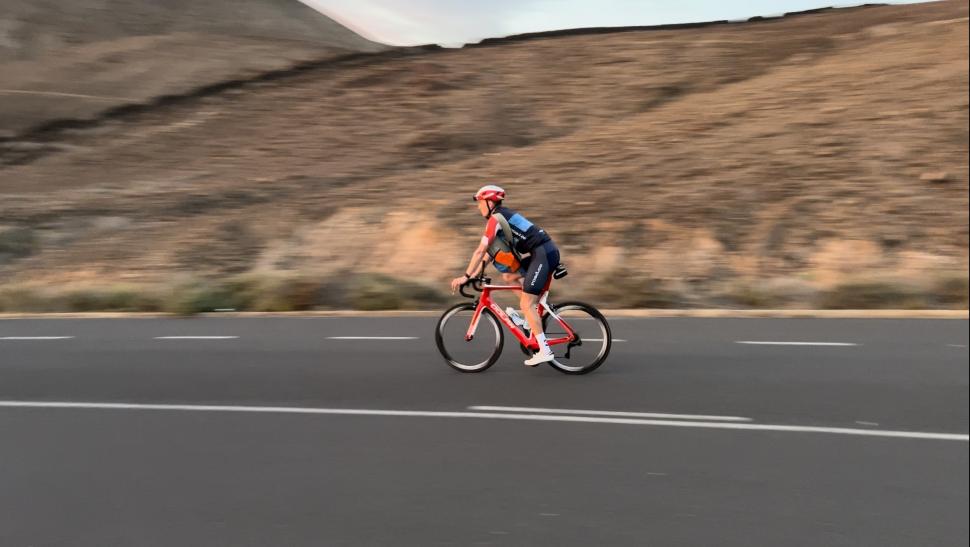- News
- Reviews
- Bikes
- Components
- Bar tape & grips
- Bottom brackets
- Brake & gear cables
- Brake & STI levers
- Brake pads & spares
- Brakes
- Cassettes & freewheels
- Chains
- Chainsets & chainrings
- Derailleurs - front
- Derailleurs - rear
- Forks
- Gear levers & shifters
- Groupsets
- Handlebars & extensions
- Headsets
- Hubs
- Inner tubes
- Pedals
- Quick releases & skewers
- Saddles
- Seatposts
- Stems
- Wheels
- Tyres
- Tubeless valves
- Accessories
- Accessories - misc
- Computer mounts
- Bags
- Bar ends
- Bike bags & cases
- Bottle cages
- Bottles
- Cameras
- Car racks
- Child seats
- Computers
- Glasses
- GPS units
- Helmets
- Lights - front
- Lights - rear
- Lights - sets
- Locks
- Mirrors
- Mudguards
- Racks
- Pumps & CO2 inflators
- Puncture kits
- Reflectives
- Smart watches
- Stands and racks
- Trailers
- Clothing
- Health, fitness and nutrition
- Tools and workshop
- Miscellaneous
- Buyers Guides
- Features
- Forum
- Recommends
- Podcast
feature
Does a heavier cyclist descend hills quicker? We strapped weights to ourselves to find out
It sounds obvious that a heavy rider will descend quicker than a light one. After all, gravity is your friend when barrelling downhill... but how much difference does it make? In an attempt to find out, we strapped 8kg to ourselves and set off to do some garage science!
Heavier riders descend quicker right? It's been ingrained in us since secondary school physics lessons. Well, that's what we thought, but look at recent descending masterclasses and it's the light riders often leading the way. Take Tom Pidcock for example, both one of the lightest and fastest descenders in the peloton, and it kind of upsets this theory.
> 14 expert tricks for better descending
> How Fast!? We take a look at Tom Pidcock's Alpe d'Huez conquering Strava file
Does this mean that weight has a far smaller impact on descending than we might have previously thought?
The test
Whilst watching Ed struggle home from the supermarket with 8kg of water, an idea popped into my head. Firstly, I wondered if I could beat him up a hill if he was 8kg heavier, and secondly I wondered if it could make him beat me down one...
To find out once and for all how much difference weight makes when descending, we found a suitable hill and devised a plan for two tests. Test number one would involve timed runs down a steep hill with and without the additional water, and the second included a roll back up the other side of the tip until Ed ground to halt. In the first test the lowest average time would win, and in test two the winner would be the one who travelled the farthest distance.
We decided that strapping the weight to Ed's front would have less of an impact on his aerodynamics than if it was on his back. It also better simulates a larger/heavier rider as this does tend to be where many of us hold that additional weight.
Results, part 1 (the steep descent)
We start off on the timed runs down the steeper of the two descents. According to Strava this had an average gradient of -10% and lasted around 40 seconds.
> Hitting 100kph on a bike — what does it take to break this elusive cycling speed barrier?
To make the results as reliable as possible, Ed wasn't allowed to pedal at any point during the descents. He got a TT-style start to avoid having to push off the line, and took the same line through the one corner each time. He also tried as hard as possible to maintain the same position throughout the testing, and we did it on the stillest day possible to try and avoid any wind gusts that could throw the results.
For the first test, Ed did a total of eight attempts, each three-quarters of a kilometre long, four with the 8kg of water and four without. Overall he was quicker (drum roll, please)... WITH the additional weight; but not by as much as you might think.
That means that the additional 8kg made Ed on average 1.5 seconds faster on our descent. That might not sound like a lot, but it is over 3% difference.
It is worth noting, however, that the weight would have less of an effect on a shallower descent, or indeed if there were more corners where braking and acceleration were required.
Results, part 2 (rolling to a halt)
> How hard is it to train like a pro cyclist? Spending a week riding like an elite
For the second test, we set Ed off down the same descent, but instead of stopping at the bottom he carried on rolling up the other side of the dip until he ground to a halt. We then measured the distance he reached each time, again four times with the 8kg of additional weight and four without.
To Ed's surprise, this time he performed better without the water strapped to him, stopping on average two meters further than when bottled up.
Why is this?
There are two main forces acting on a rider and their bike when cycling downhill. As Ed isn't pedalling, any forward acceleration is due to gravity. As you’ll remember from back in school F=ma where:
Force = mass x acceleration
Therefore, when we make Ed heavier the m in the equation gets bigger, so the force pushing him forwards gets bigger too.
However, the second major force to consider is air resistance, which opposes a rider's motion. The faster you go or the less aerodynamic you are the bigger this force gets.
As we strapped the water to Ed's front and given the results, it's unlikely that we changed Ed's drag coefficient significantly. This is why on the timed descent, Ed was quicker when carrying the additional weight.
However, when we then threw in the ascent on the other side it’s clear that the weight has more of a negative impact going up the hill than going down it, otherwise he would have travelled further.
Because air resistance has a non-linear relationship with speed, the additional weight has a far bigger impact when travelling at lower speeds, i.e uphill. Unfortunately, for many of us, this is the area we want to improve and is also where many races (both professional and on the club run) get decided.
> Power-to-weight ratio: what is W/kg, and why does it matter?
It’s for this reason that nearly all the successful general classification riders look in such depth at improving their power-to-weight ratios, and are seriously lean for target events.
Conclusion
So, does a heavier rider descend quicker? Well, yes, in a straight line at least. However, as we previously discussed your weight pales into insignificance when compared to aerodynamic drag. Therefore, if you want to get faster at descending, our advice is not to hit the all-you-can-eat buffet but rather work on your position and ditch the flappy clothing.
It's also worth noting that any advantage on the descents that you do get from being heavier will have far more of a negative impact when the road heads upwards! If you want a better idea of how much weight can slow you down, when climbing then you can check out our analysis of Tadej Pogacar's fateful climb from last year's Tour De France below.
> Did disc brakes get Pogacar dropped? How much difference does that extra 300g make?
Let us know what garage science you’d like us to do next time in the comments section below!
Jamie has been riding bikes since a tender age but really caught the bug for racing and reviewing whilst studying towards a master's in Mechanical engineering at Swansea University. Having graduated, he decided he really quite liked working with bikes and is now a full-time addition to the road.cc team. When not writing about tech news or working on the Youtube channel, you can still find him racing local crits trying to cling on to his cat 2 licence...and missing every break going...
Latest Comments
- Coolkitty 3 sec ago
Take a minute to watch cars go past. MOST have just 1 person - even the huge cars
- jaymack 7 min 16 sec ago
"At £379, the Flowbio is a significant investment...", that's something of an understatement. Evolution is smarter than even the slipperiest of...
- Hirsute 17 min 46 sec ago
A mixture of deterrence and peer pressure. Younger generations are less likely to drink and also have been brought up with the DES culture.
- mdavidford 29 min 10 sec ago
I do not think it means what you think it means. Unless there isn't actually a school ahead at all. 'Double standards', perhaps?
- BikingBud 37 min 6 sec ago
Custom bikes used to be for life....
- Bontlondon 39 min 53 sec ago
Praed Street Paddington had wands installed after taxi cabs parked in the cycle lane, now the taxis still park in the cycle lane, inside the wands.
- webbierwrex 50 min 25 sec ago
Yes! Why can't cycling shoe companies make shoes that fit feet! It's bonkers!...
- mitsky 1 hour 1 min ago
More like "bicycle-nage"...
- Hirsute 1 hour 1 min ago
Handly just outside A&E. Obviously the cyclist's fault. https://www.gazette-news.co.uk/news/25063068.car-flips-roof-outside-sout...
- hawkinspeter 2 hours 1 min ago
I bought mine as I was curious about how effective they are. I've only used it once, and luckily not even on my own bike, but it certainly inflated...










Add new comment
88 comments
This experiement could have been more useful had they only changed one variable. The mass. Here they altered mass and aerodynamics.
Doing the same runs with a full water container and also the same empty water bottle would have reduced the exeriment to the single variable actually being investigated.
This is a worryingly incorrect article with extremely bad science. When an object is accelerated by gravity, in order to move the object it must over come the objects inertia. The inertial mass of an object is the same as its gravitational mass hence to two masses cancel out in any of these equations. This was famously discovered by Galileo, running similar experiments as you did here. The difference being that he accounted for all aerodynamic veritables. Putting a ferring over your chest ans stomach is known to have aerodynamic advantages and is banned by the UCI. The only thing you did in your experiment is study aerodynamics. And all those people how go down hill faster than you skinny friends. It's not your weight that helps you! It's having more inertia from your rolling start so rolling resistance hass less effect than you might expect and the fact you have an aero gut!! Skinny people are less aero. Simple as. If you don't believe me watch the vid of astronauts dropped hammers and feathers on the moon. The difference on earth is the air resistance and that only depends on dimensions and shape!!! Also i have a phd in theoretical physics and still work in the field (just here to show I'm not a quack). Edited due to an insightful comment.
A couple of people have pointed out that they are not aware of inertia. If you have heard of it watch this veritasium vid and if you want to go deep look up the equivalence principal.
https://youtu.be/_mCC-68LyZM
You should turn in your phd if you go around saying things like "skinny people are less aero".
I've worked with a few people with a PhD in theoretical physics. It seems to require a good knowledge of higher mathematics but no knowledge of the real world. They were all complete useless pillocks.
What I find suspicious is when people feel the need to advertise their qualifications rather than letting their expertise speak for itself.
I hoped it would help you believe what i said. I also gave all the reasoning. I agree that should have spoken for it's self. Unfortunately not it seams...
Well, it shouldn't be about belief really.
The issue I have with your analysis is that you claim that their mass has no effect and that it's purely the aerodynamic differences that make heavier cyclists go quicker down hills. Their mass has a direct effect as their terminal speed is when the aerodynamic force is balanced out by their weight acting on the downhill gradient. That means that if you have two identically shaped riders (i.e. same aerodynamics), then the more massive rider will generate more weight force and thus have a higher terminal speed.
Specifically, your statement "It's not your weight that helps you!" is incorrect - a simple high-school understanding of physics/mechanics is enough to understand why that is wrong.
Yes if those where the only two forces then you would be right. But you and the author have forgotten about inertia. When you push a heavy car on a flat road its very hard untill it's up to speed. Then its easier to keep it moving and hard to stop it. Trains are a better example as they have such low rolling resistance. That's inertia. "An object at rest remains at rest, and an object in motion remains in motion at constant speed and in a straight line unless acted on by an unbalanced force". It's inertia that keeps thing moving and makes it hard to accelerate them. So when you right the equation of forces for a bike on a slope, with a standing start the mass cancels out of everything apart from rolling resistance.
Inertia does exist, but is irrelevant in this situation.
Think about the forces in a simple inclined plane diagram (high-school physics) and tell me where you draw the line for the inertia and explain why you think mass is irrelevant to the magnitude of the force down the plane (mg sin θ).
Consider that at terminal velocity, the force from the air resistance will be equal to the accelerating force (mg sin θ) and thus increasing the mass or the angle will increase the maximum speed attained.
That's a static balance of forces. We where talking about things accelerating under gravity. Weight is the name of the force gravity exerts on the object it is directly proportional to the mass and the acceleration due to gravity. So no things have weight. When an object rolling down a hill it accelerates due to its weight. And must overcome it's inertia, rolling resistance and air resistance. Inertia is also a f=ma equation. If you want to Wikipedia it search for the "equivalence principal". I'll find a YouTube vid explaining it for you and edit this.
Vid https://youtu.be/2EkHB_WtKRQ
You're not making much sense. The acceleration is due to the applied forces (due to gravity and air resistance) - do you believe that the forces are somehow different? You seem to be trying to treat inertia as a force when it's clearly not.
Please provide a simple diagram that backs up what you're trying to say.
Ok this is more in-depth than i would like but here you go.https://youtu.be/2EkHB_WtKRQ
Should have gone straight to veritasium this one is much easier to understand https://youtu.be/_mCC-68LyZM
Just seen the first one and I take issue with his statement that inertia resists motion whereas it doesn't - it resists acceleration. That's demonstrated by using Newtonian mechanics - an object in motion stays in motion unless acted upon by a force. Inertia does not apply a force and decelerate objects in motion (though air resistance will do that).
I'll have a watch of Veritasium as I like those videos, but I doubt that anything will back up what you are saying.
Thank you yes he should have said change in motion. If you find the veritasium vid contradicts me then i have done a bad jod of explaining this. Though its a short vid with little explanation. The main point he has it the one I'm trying to get across.
Okay, I've watched the Veritasium vid and it doesn't address the aerodynamics issue at all - it's just talking about inertia which is not relevant to this.
I find this discussion with you is getting tedious now.
Maybe this person has a different learning style and that's why communication is not flowing here? If they're more of a kinesthetic type or just a practical empiricist why not propose the following:
1) Ride up your favourite hill with a massive takeaway / picnic / several litres of beverages and deposit these at the top.
2) Time yourself riding down the hill. Or better, get someone else to time you. Don't pedal or use the brakes and try to stay in the same position throughout.
3) Ride back up the hill. Or take the chairlift / sticky bottle - it's only important you're back at the top again somehow.
4) Consume takeway / beverages. I would not advise alcoholic or - for practical reasons - fizzy. It's just the mass we're interested in after all.
5) Ride down hill again and note time. Try to keep the same position / line as previously.
6) Note differences between times.
7) Note that unless you are an experienced competitive eater / swallowed lead this has probably not made any more difference than taking a slightly different line down the hill or adjusting your riding position. However you've now had a couple of fun rides down your hill and a good feed / drink, so you probably don't care so much about the details any more.
If you think that a heavier object is easier to push to maintain a given velocity, even on the flat, compared to a lighter object, there is a word for you: idiot.
To be fair, it should make no difference on a flat surface if the friction is the same and no acceleration is involved. However, there's usually more friction involved with heavier objects.
Even in that idealised, totally theoretical example it's still not 'easier'.
It's easier to keep it moving than it was to accelerate it. It is much easier to accelerate a light object. This is inertia.
Yes!!! Absolutely this is how mass gets it equations related to the experiment in the vid! So a heaver object is harder to accelerate than a lighter one this applies when you roll down a hill.
I didn't say it was easier to put a heavy object on the flat! It has rolling resistance or friction and both of those are dependent on mass. It's harder to accelerate an object if its heavier. So gravity finds it jarder to accelerate an object if its heavier, hence mass cancels out in that part of the equation of motion!
No. The acceleration due to gravity is the same regardless of mass. 9.81ms^-2. Gravity does not "find it harder". Gravity is gravity.
An object with higher mass has higher potential energy (PE = m g h). When an object rolls down an inclined plane, the potential energy is converted to kinetic energy (KE = 1/2 M V^2). An object with more mass has higher potential energy for the same height and higher kinetic energy for the same speed. In this case, the masses appear to cancel out. But when accounting for resistance (which is not proportional to mass) which converts some of the kinetic energy to heat (i.e. wasted) the heavier rider would have a lower proportion of its energy wasted and therefore have a higher velocity.
I completely agree with this apart for you calculation of the forces of resistance air resistance has mo mass dependance. Rolling resistance does but should go up with mass... So if people roll down hill faster than others it must be due to aerodynamics??
Where did I say resistance is not dependant on mass? I said it's not proportional to mass. As someone with a PhD in theoretical physics, I'm sure you know what that means. More likely you have a theoretical PhD in physics (i.e. it doesn't exist).
You think they may actually be ... an accountant for instance?
I do assume that accountants need to be at least reasonably intelligent, but then when I remember that our former Prime Minister Alexander Boris de Pfeffel Johnson did not know that 0.04 and 4% were the same, it did make me question my philosophies somewhat.
As long as you can get your chums to rustle up a few hundred thou - or indeed a million, same difference - you probably don't need to be able to count e.g. how many children you've had.
I also realise my philosophies are holding me back. However my "interpersonal capabilities" / chutzpah can't compete at anywhere near the Boris level. So I guess I'll just have to keep counting the pennies and being grateful that I can.
Thanks for your lovely comment. You must be a very pleasant person. I work in an applied role and often have to deal with mathematicians and engineers who get the basics of physics wrong and cause them selves massive headaches. They to have a low option of physicists till i help them out.
My advice: stick to string theory. Your knowledge of aerodynamics and mechanics is tenuous. And that's being generous.
Pages